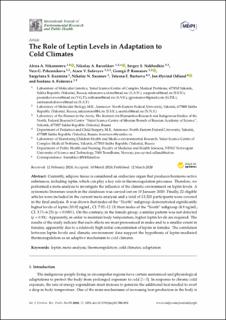| dc.contributor.author | Nikanorova, Alena A. | |
| dc.contributor.author | Barashkov, Nikolay A. | |
| dc.contributor.author | Nakhodkin, Sergey S. | |
| dc.contributor.author | Pshennikova, Vera G. | |
| dc.contributor.author | Solovyev, Aisen V. | |
| dc.contributor.author | Romanov, Georgii P. | |
| dc.contributor.author | Kuzmina, Sargylana S. | |
| dc.contributor.author | Sazonov, Nikolay N. | |
| dc.contributor.author | Burtseva, Tatiana E. | |
| dc.contributor.author | Odland, Jon Øyvind | |
| dc.contributor.author | Fedorova, Sardana A. | |
| dc.date.accessioned | 2022-12-02T08:17:46Z | |
| dc.date.available | 2022-12-02T08:17:46Z | |
| dc.date.created | 2021-02-15T18:39:15Z | |
| dc.date.issued | 2020 | |
| dc.identifier.citation | International Journal of Environmental Research and Public Health (IJERPH). 2020, 17 (6), . | en_US |
| dc.identifier.issn | 1661-7827 | |
| dc.identifier.uri | https://hdl.handle.net/11250/3035531 | |
| dc.description.abstract | Currently, adipose tissue is considered an endocrine organ that produces hormone-active substances, including leptin, which can play a key role in thermoregulation processes. Therefore, we performed a meta-analysis to investigate the influence of the climatic environment on leptin levels. A systematic literature search in the databases was carried out on 10 January 2020. Finally, 22 eligible articles were included in the current meta-analysis and a total of 13,320 participants were covered in the final analysis. It was shown that males of the “North” subgroup demonstrated significantly higher levels of leptin (10.02 ng/mL; CI: 7.92–12.13) than males of the “South” subgroup (4.9 ng/mL; CI: 3.71–6.25) (p = 0.0001). On the contrary, in the female group, a similar pattern was not detected (p = 0.91). Apparently, in order to maintain body temperature, higher leptin levels are required. The results of the study indicate that such effects are most pronounced in males and to a smaller extent in females, apparently due to a relatively high initial concentration of leptin in females. The correlation between leptin levels and climatic environment data support the hypothesis of leptin-mediated thermoregulation as an adaptive mechanism to cold climates. | en_US |
| dc.language.iso | eng | en_US |
| dc.publisher | MDPI | en_US |
| dc.rights | Navngivelse 4.0 Internasjonal | * |
| dc.rights.uri | http://creativecommons.org/licenses/by/4.0/deed.no | * |
| dc.title | The role of leptin levels in adaptation to cold climates | en_US |
| dc.title.alternative | The role of leptin levels in adaptation to cold climates | en_US |
| dc.type | Peer reviewed | en_US |
| dc.type | Journal article | en_US |
| dc.description.version | publishedVersion | en_US |
| dc.source.pagenumber | 0 | en_US |
| dc.source.volume | 17 | en_US |
| dc.source.journal | International Journal of Environmental Research and Public Health (IJERPH) | en_US |
| dc.source.issue | 6 | en_US |
| dc.identifier.doi | 10.3390/ijerph17061854 | |
| dc.identifier.cristin | 1890097 | |
| cristin.ispublished | true | |
| cristin.fulltext | original | |
| cristin.qualitycode | 1 | |

